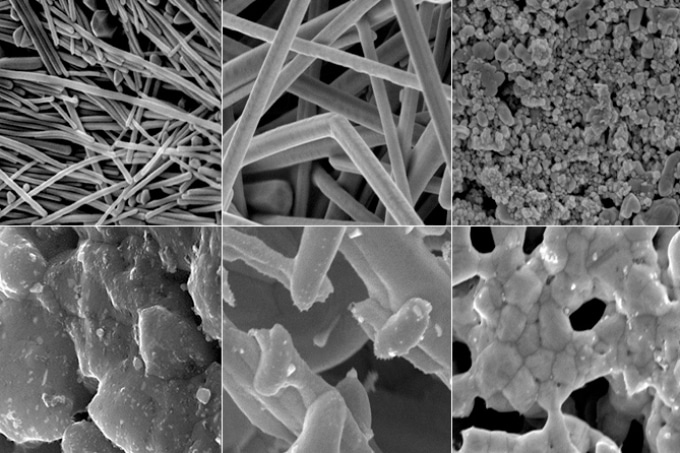Jan 4 2017
 Duke University chemists have found that silver nanowire films conduct electricity well enough to form functioning circuits without applying high heat, enabling printable electronics on heat-sensitive materials like paper or plastic. Credit: Ian Stewart.
Duke University chemists have found that silver nanowire films conduct electricity well enough to form functioning circuits without applying high heat, enabling printable electronics on heat-sensitive materials like paper or plastic. Credit: Ian Stewart.
Duke University scientists have been brewing up conductive ink-jet printer “inks” to print customizable, low-cost circuit patterns on any surface. To do this, they suspended tiny metal nanoparticles in liquids.
Printed electronics have already found large-scale use in devices such as anti-theft radio frequency identification (RFID) tags found at the back of new DVDs. However, at present they have one main disadvantage: if the circuits have to work, they have to be heated initially to melt all of the nanoparticles together into a single conductive wire, enabling the printing of circuits on low-cost plastics or paper.
In a new research, Duke University researchers demonstrated that tweaking the shape of the nanoparticles in the ink could maybe eliminate the need for heat.
The researchers compared the conductivity of films made from silver nanostructures of different shapes and discovered that electrons zip through the films made from silver nanowires mush easier than films made from other shapes such microflakes or nanospheres.
In reality, electrons zipped easily through the nanowire films in such a manner that they could function in printed circuits without even melting them all together.
The nanowires had a 4,000 times higher conductivity than the more commonly used silver nanoparticles that you would find in printed antennas for RFID tags. So if you use nanowires, then you don’t have to heat the printed circuits up to such high temperature and you can use cheaper plastics or paper. There is really nothing else I can think of besides these silver nanowires that you can just print and it’s simply conductive, without any post-processing.
Benjamin Wiley, Assistant Professor of Chemistry, Duke University
These types of printed electronics could find usage even beyond smart packaging. Scientists visualize application of the technology in fabricating solar cells, touchscreens, printed displays, amplifiers, LEDs, batteries and even many implantable bio-electronic devices. The outcomes of the research were reported online in ACS Applied Materials and Interfaces, in December 2016.
According to Wiley, silver is the most sought material for fabricating printed electronics. He also added that many studies that measure the conductivity of films using silver nanostructures of different shapes have surfaced recently. Yet, direct comparison between the shapes is highly difficult due to the experimental variations.
However, very few reports have linked the conductivity of the films with the total mass of silver used, which is a significant factor while using an expensive material.
We wanted to eliminate any extra materials from the inks and simply hone in on the amount of silver in the films and the contacts between the nanostructures as the only source of variability.
Ian Stewart, Graduate Student, Duke University
Stewart applied known formulations to create silver nanostructures of different shapes, namely, microflakes, nanoparticles, and short and long nanowires. He mixed these nanostructures using distilled water to produce simple “inks.” Then, he developed a fast and easy method to produce thin films using equipment available in any of the labs, such as double-sided tape and glass slides.
“We used a hole punch to cut out wells from double-sided tape and stuck these to glass slides,” stated Stewart. He produced different thin films to test by adding an accurate volume of ink into each tape “well” and by heating the wells either to relatively low temperature to just evaporate the water, or to high temperatures to initiate melting of the structures all together.
The research group stated that they were not surprised by the fact that the long nanowire films were found to have the highest conductivity. Wiley explained that this is because electrons normally zip through individual nanostructures very easily but get stuck while jumping from one structure to another, but long nanowires considerably decrease the number of times the electrons have to “jump.”
However, the researchers were astonished by the drastic nature of the change.
The resistivity of the long silver nanowire films is several orders of magnitude lower than silver nanoparticles and only 10 times greater than pure silver.
Ian Stewart, Graduate Student, Duke University
At present the team is analyzing the possibility of using aerosol jets to print silver nanowire inks in usable circuits. Wiley stated that the team is also looking to investigate if the same effect can be achieved using silver-coated copper nanowires, considerably inexpensive to produce when compared to pure silver nanowires.
Funding from the National Science Foundation (ECCS-1344745 and DMR-1253534) as well as a GAANN Fellowship through the Duke Chemistry Department supported the research.